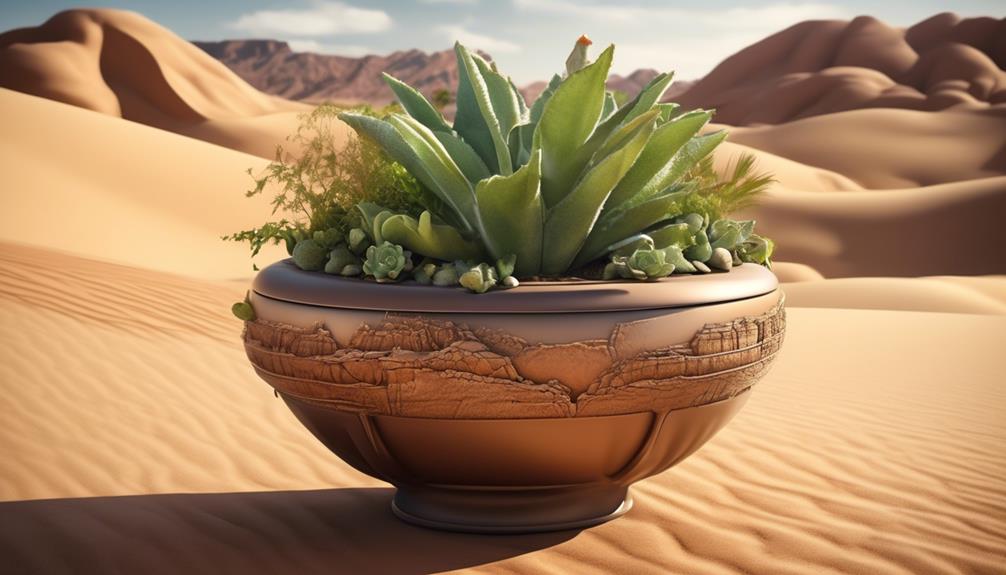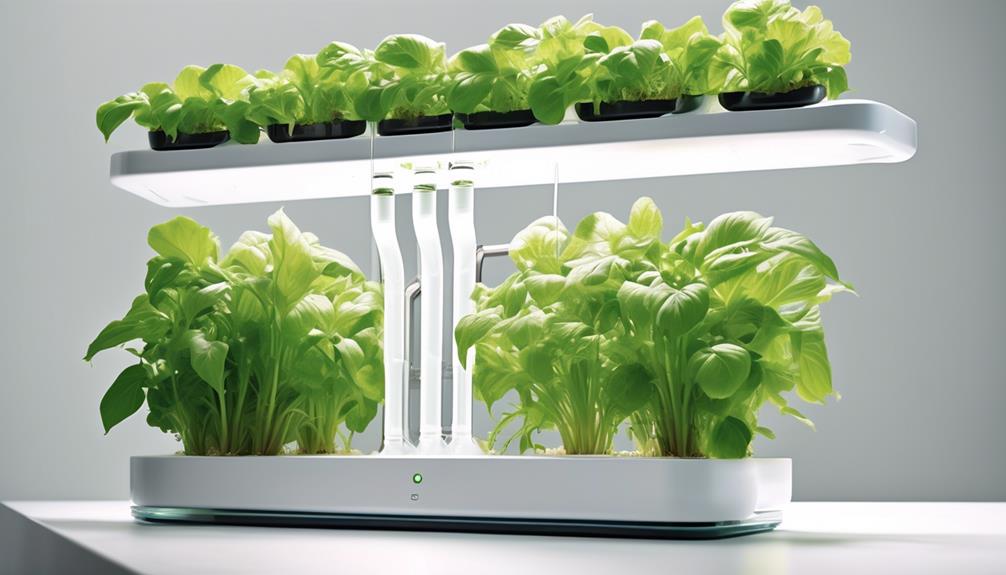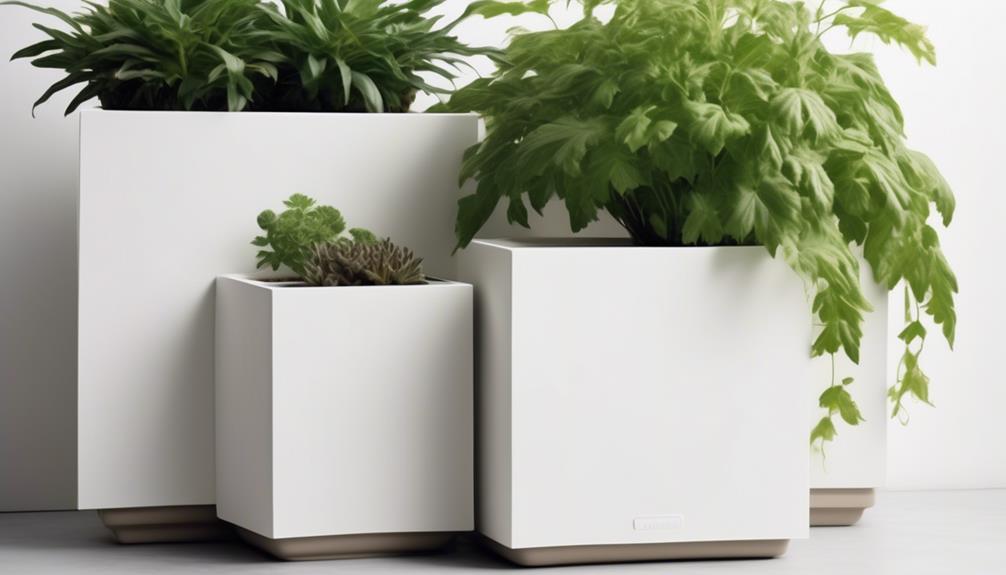In dry regions, water is crucial for survival, especially for those who are committed to gardening in these arid environments. Providing enough water for plants can be quite challenging. However, the introduction of self-watering planters has significantly decreased the effort required to keep a successful garden in these harsh landscapes.
These innovative pots offer a promising solution to the struggle of keeping plants thriving in dry environments. But do they really work? Are they practical for desert conditions?
Let's explore the potential of self-watering plant pots in the desert and uncover the best practices for their use.
Key Takeaways
- Self-watering pots in desert environments promote water conservation and ensure plants receive the right amount of water.
- They are a convenient and efficient solution for individuals with limited time or access to water sources.
- Choosing the right self-watering pot, considering watering frequency and pot size, is crucial for maintaining healthy and thriving plants in the desert.
- Drought-resistant succulents, desert-friendly herbs, and vegetables with low water requirements are suitable for self-watering pots in the desert.
Benefits of Self-Watering Plant Pots
We find that self-watering plant pots offer several benefits for maintaining healthy and thriving plants in arid environments.
Water conservation is a key advantage of these pots, as they provide a consistent and efficient water supply to the plants, reducing water wastage. The self-watering mechanism ensures that plants receive the right amount of water, minimizing the risk of overwatering or underwatering, which is crucial for optimal plant growth. This not only benefits the plants but also has a positive environmental impact by promoting responsible water usage.
Furthermore, the convenience offered by self-watering plant pots can't be overlooked. In arid environments, where regular watering may be challenging, these pots provide a reliable solution. They reduce the frequency of watering, making it practical for individuals who may have limited time or access to water sources. This convenience can be particularly beneficial for those who are dedicated to serving others by maintaining green spaces or cultivating crops in areas with water scarcity.
Choosing the Right Self-Watering Pot
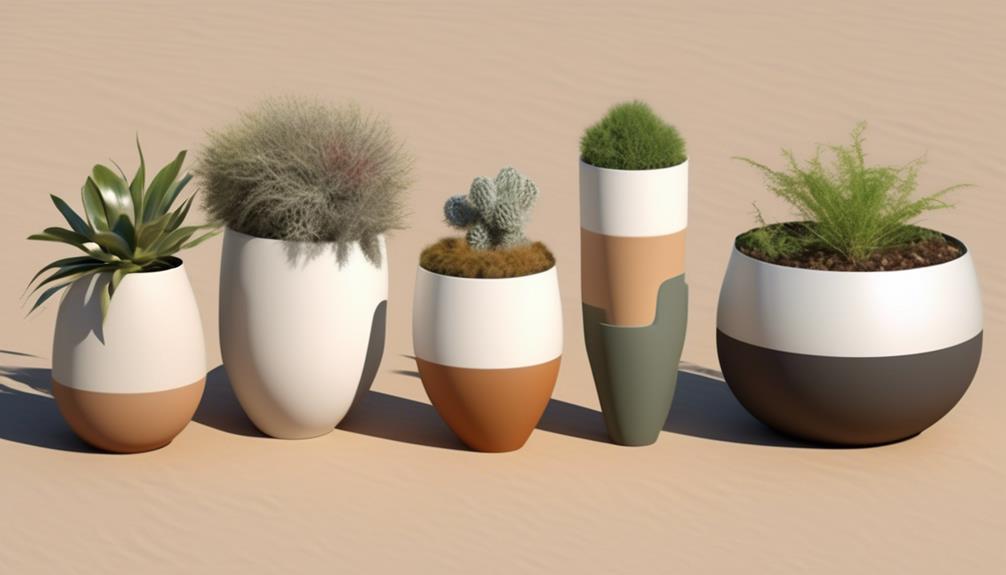
With the benefits of self-watering plant pots for maintaining healthy and thriving plants in arid environments established, selecting the appropriate self-watering pot becomes critical for ensuring optimal plant growth and water efficiency. When choosing a self-watering pot, it is essential to consider the watering frequency and pot size to meet the specific needs of the plant.
| Consideration | Description |
|---|---|
| Watering frequency | Choose a self-watering pot with an adjustable watering system to regulate moisture levels based on the plant's requirements. This feature allows the plant to access water as needed, reducing the risk of over or under-watering. |
| Pot size | Select a pot that accommodates the plant's root system while providing ample space for growth. A pot that is too small can restrict root development, while a pot that is too large may lead to water stagnation, affecting the plant's health. Ensure the pot size aligns with the plant's size and growth potential. |
Considering the watering frequency and pot size when selecting a self-watering pot allows for precise care tailored to the plant's needs, promoting healthy growth and water conservation.
Tips for Planting in Self-Watering Pots
Planting in self-watering pots requires careful consideration of the soil composition and proper placement of the plant to ensure optimal growth and water retention. When choosing a soil mix for self-watering pots, it's essential to select a well-draining mix that retains moisture, such as a combination of peat moss, vermiculite, and perlite. This type of soil composition allows for adequate water retention while preventing waterlogged conditions that can lead to root rot.
When planting in self-watering pots, it's important to consider the watering schedule. Initially, the soil should be moistened before planting the vegetation. After planting, set the pot in a tray of water and allow the soil to absorb the necessary moisture from the bottom up. Once the soil is adequately hydrated, the watering schedule can be adjusted based on the plant's individual needs and environmental conditions. Regularly monitor the moisture levels in the soil to prevent overwatering or underwatering.
Additionally, employing proper planting techniques, such as ensuring the root ball is adequately covered with soil and gently tamping the soil to remove air pockets, can contribute to the plant's successful growth in a self-watering pot. By following these tips, individuals can effectively utilize self-watering pots to support healthy plant growth even in arid environments.
Maintenance and Care for Self-Watering Pots
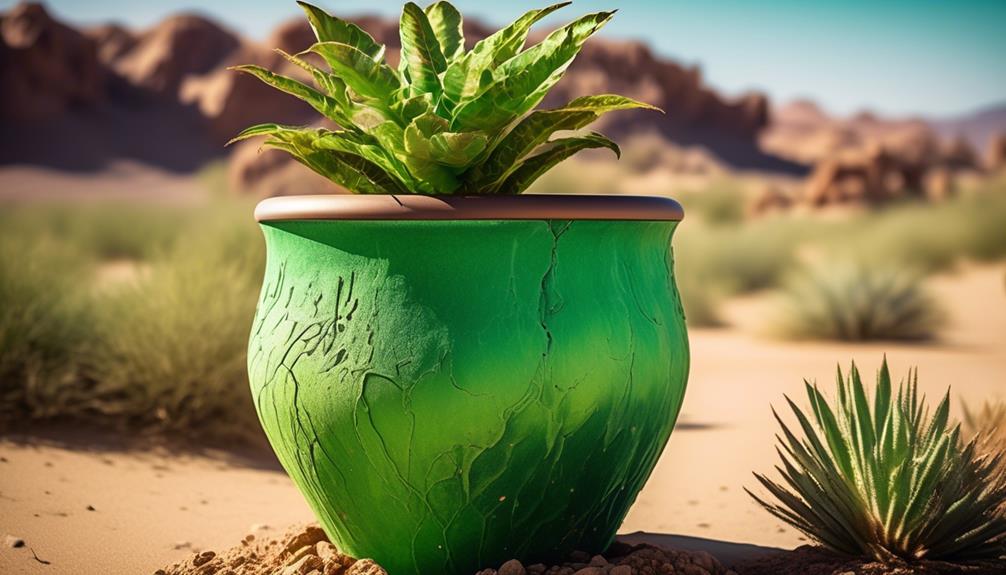
To maintain and care for self-watering pots, it is essential to regularly monitor the water levels and adjust the watering schedule based on the plant's needs and environmental conditions. Proper maintenance ensures that the plants receive adequate moisture without the risk of overwatering. Monitoring the soil moisture and adjusting the watering frequency accordingly is crucial for the health of the plants.
| Watering Frequency | Soil Moisture |
|---|---|
| High | Moist |
| Medium | Slightly moist |
| Low | Dry |
| Varied | Varied |
The table above provides a general guideline for adjusting the watering frequency based on the soil moisture levels. It is important to note that individual plant species may have specific requirements, so it is advisable to research the particular needs of the plants in your self-watering pots. Additionally, regular inspection of the pot's water reservoir is necessary to ensure that it is clean and functioning properly. By maintaining proper watering practices and monitoring soil moisture, we can ensure the optimal growth and health of the plants in self-watering pots.
Best Plants for Self-Watering Pots in Desert
When selecting plants for self-watering pots in the desert, it's crucial to choose species that are well-adapted to arid conditions and have low water requirements. Drought-resistant succulents and cacti are excellent choices for self-watering pots in desert environments. Species such as aloe vera, agave, and echeveria not only thrive in dry conditions but also store water in their leaves, making them ideal for self-watering pots. These plants require minimal maintenance and are well-suited to the harsh desert climate.
In addition to succulents and cacti, desert-friendly herbs and vegetables can also thrive in self-watering pots. Herbs such as rosemary, thyme, and oregano are well-suited to desert environments, requiring little water to flourish.
When it comes to vegetables, options like cherry tomatoes, peppers, and kale can be grown successfully in self-watering pots in the desert, providing fresh produce with minimal water consumption.
Frequently Asked Questions
Can Self-Watering Plant Pots Be Used for Any Type of Plant, or Are There Specific Plants That Are Not Suitable for This Type of Pot?
We find that self-watering plant pots are suitable for a wide variety of plants. Factors such as watering frequency and soil type play a role in determining compatibility. Plants that thrive in well-draining soil and require consistent moisture, like ferns and peace lilies, are well-suited for self-watering pots.
However, plants with specific watering needs, such as succulents or cacti, may not be suitable for self-watering pots.
Are Self-Watering Plant Pots Suitable for All Types of Soil, or Are There Certain Types of Soil That Work Best With These Pots in a Desert Environment?
In a desert environment, self-watering plant pots are suitable for all types of soil, but certain soil types work best. The best soil types are those with good drainage, such as sandy loam or cactus mix. These soil types help maintain optimal moisture levels for the plants.
When it comes to plant compatibility, desert-adapted plants like succulents and cacti thrive in self-watering pots with the right soil.
How Often Should the Water Reservoir in a Self-Watering Plant Pot Be Refilled in a Desert Environment, and Are There Any Special Considerations for Hot and Dry Climates?
In a desert environment, the frequency of refilling the water reservoir in a self-watering plant pot is crucial for plant survival. Factors like the type of plant, pot size, and climate affect the watering schedule.
Understanding the specific water needs of your plants is essential for their health. It's important to consider the unique requirements of hot and dry climates, as these can impact the rate of evaporation and water uptake.
Are There Any Special Precautions or Maintenance Tasks That Need to Be Taken to Prevent Mold or Algae Growth in the Water Reservoir of a Self-Watering Plant Pot in a Desert Environment?
To prevent mold and algae growth in the water reservoir of self-watering plant pots in a desert environment, regular maintenance tasks are essential.
Cleaning the reservoir and changing the water frequently can help control microbial growth.
Additionally, adding a few drops of hydrogen peroxide to the water can inhibit mold and algae.
These precautions are crucial for maintaining a healthy environment for plants in self-watering pots in a desert climate.
Can Self-Watering Plant Pots Be Used in Outdoor Desert Environments, or Are They Only Suitable for Indoor Use?
Yes, self-watering plant pots can be used in outdoor desert environments. The durability of outdoor use depends on the material and quality of the pot. In desert climates, watering frequency needs to be closely monitored due to the arid conditions.
Proper maintenance and selecting pots designed for outdoor use are crucial. As the saying goes, 'a stitch in time saves nine,' so timely care and attention can ensure successful use of self-watering pots in desert settings.
Are Self-Watering Plant Pots Suitable for Hanging Plants in a Desert Environment?
Yes, self watering hanging plant pots are suitable for hanging plants in a desert environment. These pots provide a consistent water supply, reducing the need for frequent watering in dry climates. They can help desert-dwelling plants thrive by maintaining optimal moisture levels without the risk of dehydration.
Conclusion
In conclusion, self-watering plant pots offer an innovative solution for growing plants in the desert.
By providing a consistent water supply, these pots help plants thrive in arid conditions.
When choosing the right pot and planting the appropriate species, you can create a flourishing oasis in even the most challenging environments.
With proper maintenance and care, self-watering pots are a practical and effective way to bring greenery to the desert landscape.

